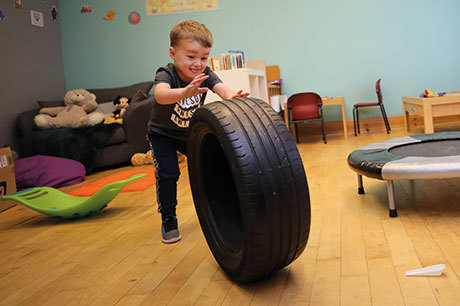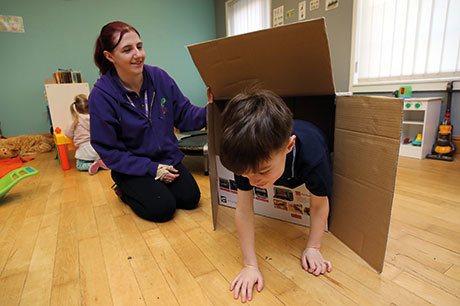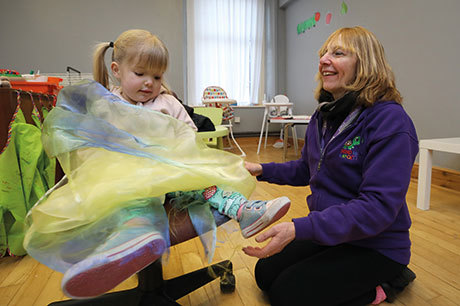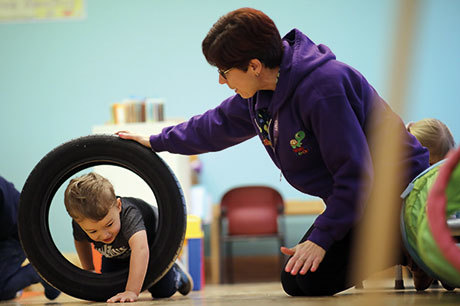
Download the PDF of this article
Proprioception is a long word for something relatively simple, once we know what it is. Like vestibular development, it is fundamental and something we are almost unaware of once it is fully developed and working properly.
The term comes from the Latin ‘proprius’, which means ‘one’s own’. It helps to know this, as it is proprioception that provides us with a sense of our bodily selves – ‘a dynamic sensory-motor map of the body’ (LeVoguer and Pasch 2014), or our very own personal satnav, helping us understand our bodies in relation to our environment (Connell and McCarthy 2014).
It is what lets you know where your body begins and ends in relation to the world around you, but also provides a sense of bodily intuition that means once we have a degree of automatic mastery, we don’t have to think about many of the movements we make or how we use our bodies to conduct our daily lives.
WHERE IS IT?
Our proprioceptive system is pretty much everywhere. Every nerve-ending in our limbs and in the inner ear have sensors – proprioceptors – that receive sensory information about the position and angle of our joints and contraction of our muscles. These send signals to the brain about ‘your position in space, your relationship to that space and the current conditions of the environment and objects you encounter’ (Connell and McCarthy 2014).
Proprioception is what helps us run up and down stairs without watching our feet or walk through a narrow door without bumping into the door frame.
We do this not so much by looking where we are going, but by an inner sense that enables us to judge where we are in relation to the space available, how well we fit into it and what we might need to do in order to negotiate that space and any objects in it.
Infants getting up on their feet and beginning to toddle around need to pay a lot of attention to where they place their feet and hands and position themselves. Imagine how much this would slow down our movements if this were still the case when we are adults? It is our developing proprioceptive sense that enables an unquantifiable number of movements to take place all the time, with us hardly even being aware of them.
This is a very important feature of proprioception as it is thought that most of the sensory input is processed in parts of the brain that do not produce conscious awareness. ‘Even if we try to be aware, we feel only a small fraction of all the proprioception that is present during movement’ (Ayres 2005).
WHAT DOES IT DO?
As well as not bumping into door frames, proprioception is essential for sports and dance, as well as everyday things such as driving a car (using pedals, steering wheel, etc. while focusing on the road), tying apron strings behind your back, touch-typing on a keyboard and even walking in the dark. It is also how we learn to judge and moderate our own strength in relation to grip as well as when lifting, carrying, pushing and pulling, etc. Even more importantly, it helps us ‘feel at home’ in our own bodies, which is essential for our mental health and well-being (LeVoguer and Pasch 2014).
Having a ‘felt’ sense of direction and position also supports our language development in general and more specifically with regard to mathematical and spatial language as well as emotional literacy. It can also help with literacy development as, for example, it helps embed a bodily sense of how ‘d’ and ‘b’ face in different directions (Connell and McCarthy 2014).
HOW DOES IT DEVELOP TYPICALLY?
As with vestibular development, movement is key to proprioception and children will instinctively seek out the kinds of activity that help them develop well-organised ‘body maps’. Running, jumping, hopping, bouncing, climbing and stretching all help to reinforce messages about body position and provide the brain with the appropriate stimulation.
Self-initiated repetition is vital to support the automatic mastery of everyday movement skills, as well as laying the foundations for the later skills and techniques needed to engage with sports, dance, arts and technology. Vigorous playground activity (for example, on swings and monkey bars) and regular ‘rough and tumble’ or ‘cub play’ is also very important.
‘Heavy work’ is often overlooked but is also fundamental to proprioceptive development. Children naturally and enthusiastically engage in pushing and pulling, lifting and carrying, brushing and sweeping as they purposefully transport toys around, build dens and play with building blocks – and then tidy up and take part in meaningful daily chores. Energetic ‘tidy-up time’ isn’t just fun, it’s also stimulating brain growth and development.
Equally of value is clambering in and out of baskets, cupboards, cardboard boxes and home-made dens, all of which helps with sensory integration as children’s bodies continuously grow and develop. Just like all the other senses, proprioception does not develop in isolation and relies on multisensory experience to support integration and effective processing.
Healthy development
‘The well-organised brain uses sensory information to plan actions without deliberate thinking, resulting in automatic ease and gracefulness’ (Ayres 2005). Having well-organised body maps helps us to:
- ‘feel’ our bodies more accurately and reinforce a sense of self – on the inside as well as the outside
- co-ordinate our movements and judge how we fit into spaces
- navigate our way successfully around our physical environment – that is, not bump into things!
- use strength and muscular effort appropriately for the task
- process efficiently information about the different parts of our bodies (for example, left and right, top and bottom, and front and back) and how they work together or separately
- automatically know left from right rather than having to think about it first
- build spatial awareness and reasoning
- multi-task physically throughout our daily lives and not waste time, energy and brain space on tasks that our bodies can do automatically.
Developmentally appropriate activities
Just like our vestibular system, proprioception takes time to develop and the rate of development is different for each of us. It is, therefore, vital to follow the lead of the child and to recognise that issues with spatial awareness, co-ordination and muscular strength sometimes may just require us to be more in tune with a child’s stage of proprioceptive development, rather than treat problems (such as aggressive behaviour like biting or kicking) purely as ‘bad behaviour’.
Observe children’s physical activity just as you would any other area of learning and respond with suitable spontaneous proprioceptive play as well as short bursts of structured activity in small groups, as and when appropriate.
PROBLEMS WITH PROPRIOCEPTIVE PROCESSING
One of the key figures in sensory integration, Dr A Jean Ayres, describes a child who is not naturally developing an increasingly organised body map as usually having ‘a lot of trouble doing anything when they cannot see it with their eyes’. This is because the physical mastery required for many basic physical tasks has not become automatic and still requires conscious motor planning or ‘praxis’ to make it happen.
It is likely, therefore, that children who have difficulties with co-ordination and other related aspects are having to do too much motor planning rather than not enough. Difficulties with co-ordination and gross and/or fine motor planning may lead to a diagnosis of Developmental Co-ordination Disorder (DCD), also known as dyspraxia (see www.dyspraxiafoundation.org.uk).
It has been suggested that this link between our sense of self and our ability to see our bodies physically might also have a bearing on the difficulties that some children have sleeping on their own or in the dark.
Until proprioception is fully developed, it can be emotionally very unsettling not to be able to see one’s own body in the dark. So, a nightlight or the touch of someone next to them as they fall asleep might be all some children need until their proprioception is more fully developed.
Similarly, some children and adults are soothed by weighted blankets or being ‘cocooned’ in sleeping bags that provide the required amount of proprioceptive feedback to aid sleep.
As with the other senses, sometimes there are problems modulating sensory input, and issues with proprioceptive processing can take the form of under- (hypo) sensitivity or over- (hyper) sensitivity to stimulation.
UNDER-SENSITIVE
Children with under-sensitive proprioception require extra input to help them become more proprioceptively aware, and they are constantly seeking it – often through the kinds of behaviour and activity that will get them into trouble. They may:
- be unable to judge strength appropriately when writing/using tools or when playing (such as breaking toys or hurting others)
- seek proprioceptive stimulation inappropriately by biting or kicking or giving unwanted hugs
- be extremely energetic, ‘bouncing off the walls’ and bumping into things
- have no sense of personal space, struggle with lining up or keeping their hands to themselves
- prefer clothes to be tight
- chew toys, pencils, their fingers, etc.
OVER-SENSITIVE
Because the brain is unable to turn down or suppress the sensory information, for these children even a normal amount of proprioceptive stimulus can be hard to tolerate. They may:
- not have a strong enough grip for pencils/scissors
- resist physical contact with others and sand, water, paint, dirt, etc.
- avoid physical activity, appearing lethargic and overly still. This self-protective behaviour might cause them to be labeled ‘lazy’
- lack co-ordination and seem accident-prone.
NB: Clinical assessments ofsensory processing issues must be carried out by anappropriately qualifiedoccupational therapist. Always seek advice and guidance if you are concerned about a child.
SUPPORTING PROPRIOCEPTIVE DEVELOPMENT AT SEND TO LEARN NURSERY

A young girl started nursery with a reputation for biting, hitting and being ‘rough’. After some observations, it became obvious that this behaviour had very little to do with aggressiveness or being unsociable. There was a more deep-seated need that was driving this child to exhibit unwanted, inappropriate behaviour.
We observed that she had a constant need to bite down, stamp, push and exert a lot of force. She also found it difficult to walk without stamping, had poor balance and poor posture and was often described as a clumsy child.
To help with the biting, we provided her with a ‘chewie’, which after a few weeks of intensive work she learnt to chew down on, instead of other people. This provided her with the input she needed and also helped her focus and concentrate.
At a push
We discovered that she liked the doll’s pushchair, not to put a dolly in it but to push around. So we made sure that this was available for her every morning when she came in. By pushing it around, she automatically received the sensory input she craved and it was an acceptable everyday nursery activity.
This pushchair came everywhere with us and we also taught her how to safely push around one of our little ones who used a wheelchair, which resulted in a lovely friendship.
Because of her need to apply pressure throughout her body, we used an old office swivel chair for her. It worked brilliantly because she could lie her stomach on it while her feet still touched the floor and push herself around and at the same time bite down on the seat rim of the chair or bite on her ‘chewie’, thereby fulfilling all of her proprioceptive needs.
Weighted clothing
If we saw her levels of sensory-seeking rise and the pushchair and office chair were not enough, then we would provide her with a weighted backpack. This was a small child’s rucksack weighted down with books or a toy. She would wear this for short periods of time and it would provide her with the additional input she required. (Please make sure you check with occupational therapists before giving children weighted items.)
She also wore, for short periods, a Lycra base layer T-shirt, which was tight-fitting but stretchy and provided her with the sensory input she craved. ‘Squease vests’ are a similar alternative, but again, always check with an occupational therapist before using them.
During group and story time, the girl was helped with a weighted blanket covering her legs or by staff giving her a deep pressure massage to help calm and ‘ground’ her. (Any deep pressure massage needs to be carried out by trained staff.)
When we went on visits, she wore the base layer and backpack and sometimes took the pushchair. She looked like any other nursery child on an outing and was able to cope well.
We incorporated the chair and pushchair into other learning activities; so, for example, she would push herself on the chair to different objects, wheel the pushchair to different directed areas, use the pushchair to collect things or lie across the chair to share stories.
Huge reduction
Nursery staff carried out short, focused proprioceptive activities on a regular basis throughout the day, including yoga and using ‘theraputty’ playdough, and a Nexus MagnePad Tablet, which helped her work out the amount of pressure she had to apply through her fingers. We saw a huge reduction in the occurrence of biting and other inappropriate behaviour, which led to a development of friendships, an improvement in concentration and her ability to focus.
Her mother adopted the same procedure at home, which enabled her to take her daughter out in the community and to family events and activities with less chance of her biting or hurting others.
This little one has now left us and attends a Reception class in a local SEN school, and she has just learned to ride a scooter.
WHERE TO BUY PRODUCTS
‘Chewies’ or ‘Chewelry’: www.sensetoys.com, www.sensorydirect.com, www.cheapdisabilityaids.co.uk, eBay and Amazon
Squease vests: www.sensetoys.com, www.sensorydirect.com, www.squeasewear.com, www.specialneedstoys.com , eBay and Amazon
Base layer clothing, from outdoor adventure or sports shops
MagnePad Tablet, www.nexus-euro.co.uk
Theraputty, www.physioparts.co.uk, www.nrshealthcare.co.uk and Amazon
REFERENCES AND FURTHER READING
‘Physical well-being: Autonomy, exploration and risk-taking’ by LeVoguer M and Pasch J in Exploring Well-being in the Early Yearsby Julia Manning-Morton (Ed), 2014
Right from the Start by Archer Cet al. Early Years Alliance
Sensory Integration and the Childby A Jean Ayres
A Moving Child is a Learning Child by Gill Connell and Cheryl McCarthy
Understanding Physical Development: Linking bodies and brainsby Anne O’Connor and Anna Daly
Proprioception cheat sheet, https://bit.ly/2H8l8S6
About this series
Our five external senses (touch, sight, hearing, smell and taste) and three internal senses (interoceptive, vestibular and proprioceptive) are constantly sending messages to our brains – a process that we often barely register. Yet this sensory information is vital in helping us understand and make sense of the world.
Typical sensory development occurs naturally in childhood. However, for some children this doesn’t happen, causing sensory processing difficulties that impair development and are manifested in children’s behaviour.
Advice and support
Part one of this series provides an introduction to typical and atypical sensory processing and integration. The rest of the series will look at the senses individually, explaining the causes, symptoms and effects of sensory problems and giving advice on how to adapt provision and practice to address a child’s sensory difficulties.
Series authors
Anne O’Connor is an early years consultant and author, specialising in the Prime areas of development (www.primedforlife.co.uk).
Dr Kath Dickinson is owner of SEND to Learn Nursery in Blyth, Northumberland. She has a doctorate in SEND (autism).









